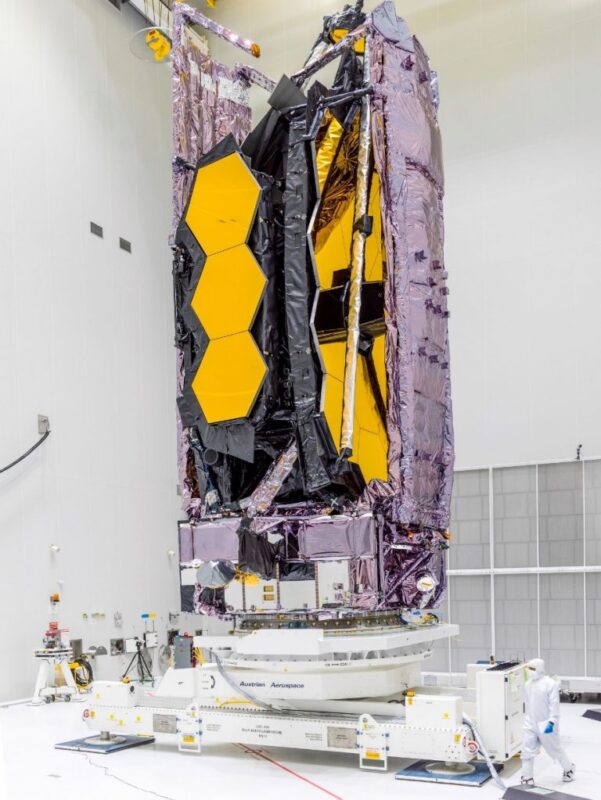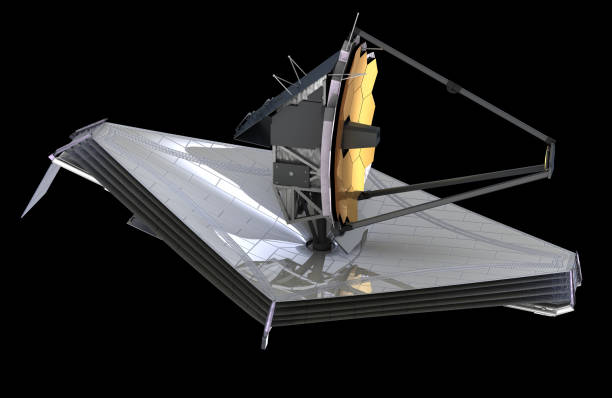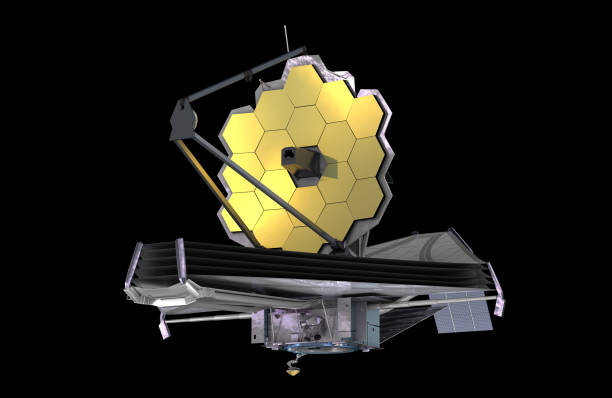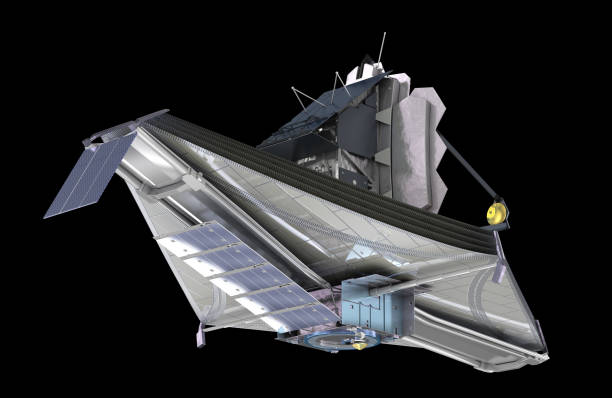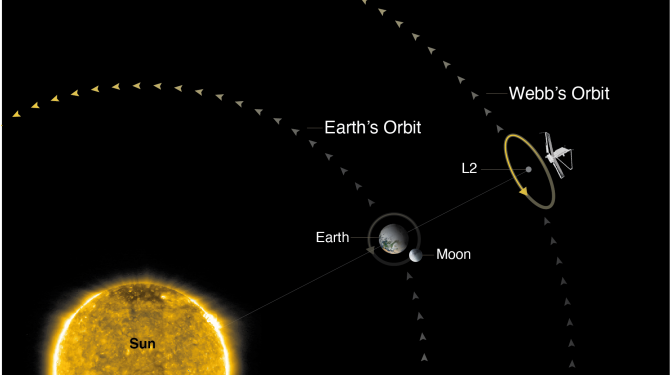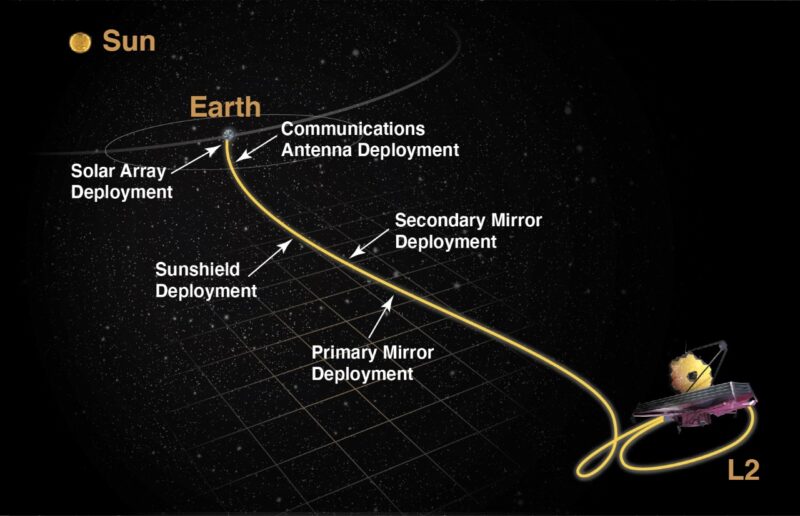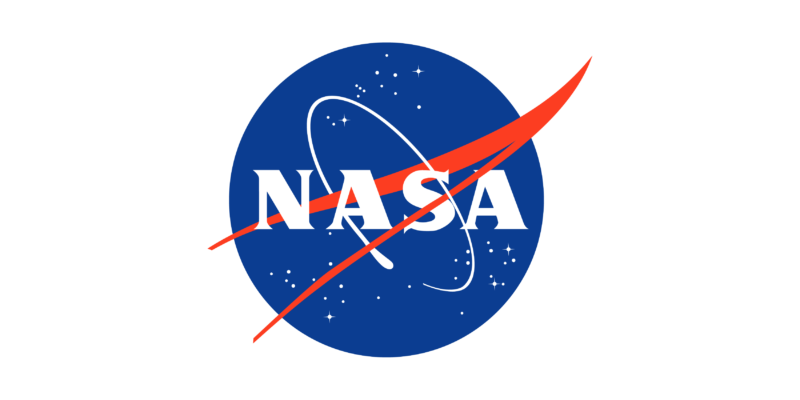
About The James Webb Space Telescope – Webb will be the world’s premier space science observatory when it launches in 2021. Webb will solve mysteries in our solar system, look beyond to distant worlds around other stars, and probe the mysterious structures and origins of our universe and our place in it. Webb is an international program led by NASA with its partners, ESA (European Space Agency) and the Canadian Space Agency.
The James Webb Space Telescope is a large, infrared-optimized space telescope. Webb will find the first galaxies that formed in the early Universe, connecting the Big Bang to our own Milky Way Galaxy. Webb will peer through dusty clouds to see stars forming planetary systems, connecting the Milky Way to our own Solar System. Webb’s instruments are designed to work primarily in the infrared range of the electromagnetic spectrum, with some capability in the visible range.
Webb will have a large primary mirror, 6.5 meters (21.3 feet) in diameter and a sunshield the size of a tennis court. Both the mirror and sunshade won’t fit onto the Ariane 5 rocket fully open, so both will fold up and open once Webb is in outer space. Webb will operate in an orbit about 1.5 million km (1 million miles) from the Earth. The James Webb Space Telescope was named after the NASA Administrator who crafted the Apollo program, and who was a staunch supporter of space science.
Development began in 1996, with Webb’s construction beginning in 2004, however, the launch has been pushed back several times due to cost, design overhauls, COVID-19,, more than 10,000 people have worked on the project and the budget is expected to cost NASA $9.7 billion over 20 years.
On Saturday, Dec. 11, NASA’s James Webb Space Telescope was secured on top of the Ariane 5 rocket that will launch it to space from Europe’s Spaceport in French Guiana.
On Tuesday, December 14, 2021, NASA announced the James Webb Space Telescope team is working a communication issue between the observatory and the launch vehicle system. This will delay the launch date to no earlier than Friday, Dec. 24. We will provide more information about the new launch date no later than Friday, Dec. 17.
Webb will be launched from Arianespace’s ELA-3 launch complex at European Spaceport located near Kourou, French Guiana. It is beneficial for launch sites to be located near the equator – the spin of the Earth can help give an additional push. The surface of the Earth at the equator is moving at 1670 km/hr
WATCH LIVE HERE: Update launch date/time and livestream will be added here when then become available!
KEY FACTS
| Proposed Launch Date: | December 24, 2021, 7:20 a.m., EST |
| Launch Vehicle: | Ariane 5 ECA |
| Mission Duration | 5 – 10 years |
| Total payload mass: | Approx 6200 kg, including observatory, on-orbit consumables and launch vehicle adaptor. |
| Diameter of primary Mirror: | 6.5 m (21.3 ft) approximately |
| Clear aperture of primary Mirror: | 25 m2 |
| Primary mirror material: | beryllium coated with gold |
| Mass of primary mirror: | 705 kg |
| Mass of a single primary mirror segment: | 20.1 kg for a single beryllium mirror, 39.48 kg for one entire primary mirror segment assembly (PMSA). |
| Focal length: | 131.4 meters |
| Number of primary mirror segments: | 18 |
| Optical resolution: | ~0.1 arc-seconds |
| Wavelength coverage: | 0.6 – 28.5 microns |
| Size of sun shield: | 21.197 m x 14.162 m (69.5 ft x 46.5 ft) |
| Temp of sun shield layers: | Layer 1: Max temperature 383K = approx 231FLayer 5: Max temperature 221K = approx -80F Min temperature 36K = approx -394F |
| Orbit: | 1.5 million km from Earth orbiting the L2 Point (Lagrange point) |
| Operating Temperature: | under 50 K (-370 °F) |
| Gold coating: | Thickness of gold coating = 100 x 10-9 meters (1000 angstroms). Surface area = 25 m2. Using these numbers plus the density of gold at room temperature (19.3 g/cm3), the coating is calculated to use 48.25g of gold, about equal to the mass of a golf ball. (A golf ball has a mass of 45.9 grams. Note mass does not equal size!) |
How long will it take Webb to reach its orbit?
Webb will orbit around the second Lagrange (L2) point, which is about 1 million miles (1.5 million km) away from Earth, and it takes about a month to travel this distance. During the trip to Lagrange point (L2), Webb will be fully deployed, will cool down to its operating temperature, and its systems will begin to be checked out and adjusted. These check-out procedures will continue until 6 months after launch, at which point routine scientific operations will begin. (See also Question 14 above and our deployment video.
What happens after Webb is launched?
- In the first hour: The ride to space, solar array deployment, and “free flight.” The Ariane 5 launch vehicle will provide thrust for roughly 26 minutes after a morning liftoff from French Guiana. Moments after second stage engine cut-off, Webb will separate from the Ariane, which will trigger the solar array to deploy within minutes so that Webb can start making electricity from sunshine and stop draining its battery. Webb will quickly establish its ability to orient itself and “fly” in space.
- In the first day: Mid-course correction to L2 Ariane will have sent Webb on a direct route to L2, without first orbiting Earth. During the first day, we will execute the first and most important trajectory correction maneuver using small rocket engines aboard Webb itself. We will also release and deploy the high gain antenna to enable the highest available rates of data communication as early as practical.
- In the first week: Sunshield deployment. Shortly after we execute a second trajectory correction maneuver, we will start the sequence of major deployments, beginning with the fore and aft sunshield pallets. The next step is separation of the spacecraft bus and telescope by extending the telescoping tower between them. The tower will extend about 2 meters, and it is necessary at this point in the sequence so that the rest of the sunshield deployment can proceed. Next, the sunshield membranes will be unpinned and the telescoping sunshield midbooms will extend – first the port side and then the starboard side – pulling the membranes out with them. The last sunshield deployment step is tensioning of the membranes. In the meantime, other things like radiators will be released and deployed.
- In the first month: Telescope deployment, cooldown, instrument turn-on, and insertion into orbit around L2. During the second week after launch we will finish deploying the telescope structures by unfolding and latching the secondary mirror tripod and rotating and latching the two primary mirror wings. Note that the telescope and scientific instruments will start to cool rapidly in the shade of the sunshield, but it will take several weeks for them to cool all the way down and reach stable temperatures. This cooldown will be carefully controlled with strategically-placed electric heater strips so that everything shrinks carefully and so that water trapped inside parts of the observatory can escape as gas to the vacuum of space and not freeze as ice onto mirrors or detectors, which would degrade scientific performance. We will unlock all the primary mirror segments and the secondary mirror and verify that we can move them. Near the end of the first month, we will execute the last mid-course maneuver to insert into the optimum orbit around L2. During this time we will also power-up the scientific instrument systems. The remaining five months of commissioning will be all about aligning the optics and calibrating the scientific instruments.
- In the second, third and fourth months: Initial optics checkouts, and telescope alignment. Using the Fine Guidance Sensor, we will point Webb at a single bright star and demonstrate that the observatory can acquire and lock onto targets, and we will take data mainly with NIRCam. But because the primary mirror segments have yet to be aligned to work as a single mirror, there will be up to 18 distorted images of the same single target star. We will then embark on the long process of aligning all the telescope optics, beginning with identifying which primary mirror segment goes with which image by moving each segment one at a time and ending a few months later with all the segments aligned as one and the secondary mirror aligned optimally. Cooldown will effectively end and the cryocooler will start running at its lowest temperature and MIRI can start taking good data too.
- In the fifth and sixth months: Calibration and completion of commissioning. We will meticulously calibrate all of the scientific instruments’ many modes of operation while observing representative targets, and we will demonstrate the ability to track “moving” targets, which are nearby objects like asteroids, comets, moons, and planets in our own solar system. We will make “Early Release Observations,” to be revealed right after commissioning is over, that will showcase the capabilities of the observatory.
- After six months: “Science operations!” Webb will begin its science mission and start to conduct routine science operations.
By Alise Fishe, Public Affairs Specialist at NAS
Jonathan Gardner, Webb deputy senior project scientist, NASA’s Goddard Space Flight Center
Alexandra Lockwood, project scientist for Webb science communications, Space Telescope Science Institute.
All photos belong to NASA, ESA, and the Canadian Space Agency, taken by NASA/Chris Gunn, and the European Space Agency (ESA) by ESA- M.Pedoussaut.
